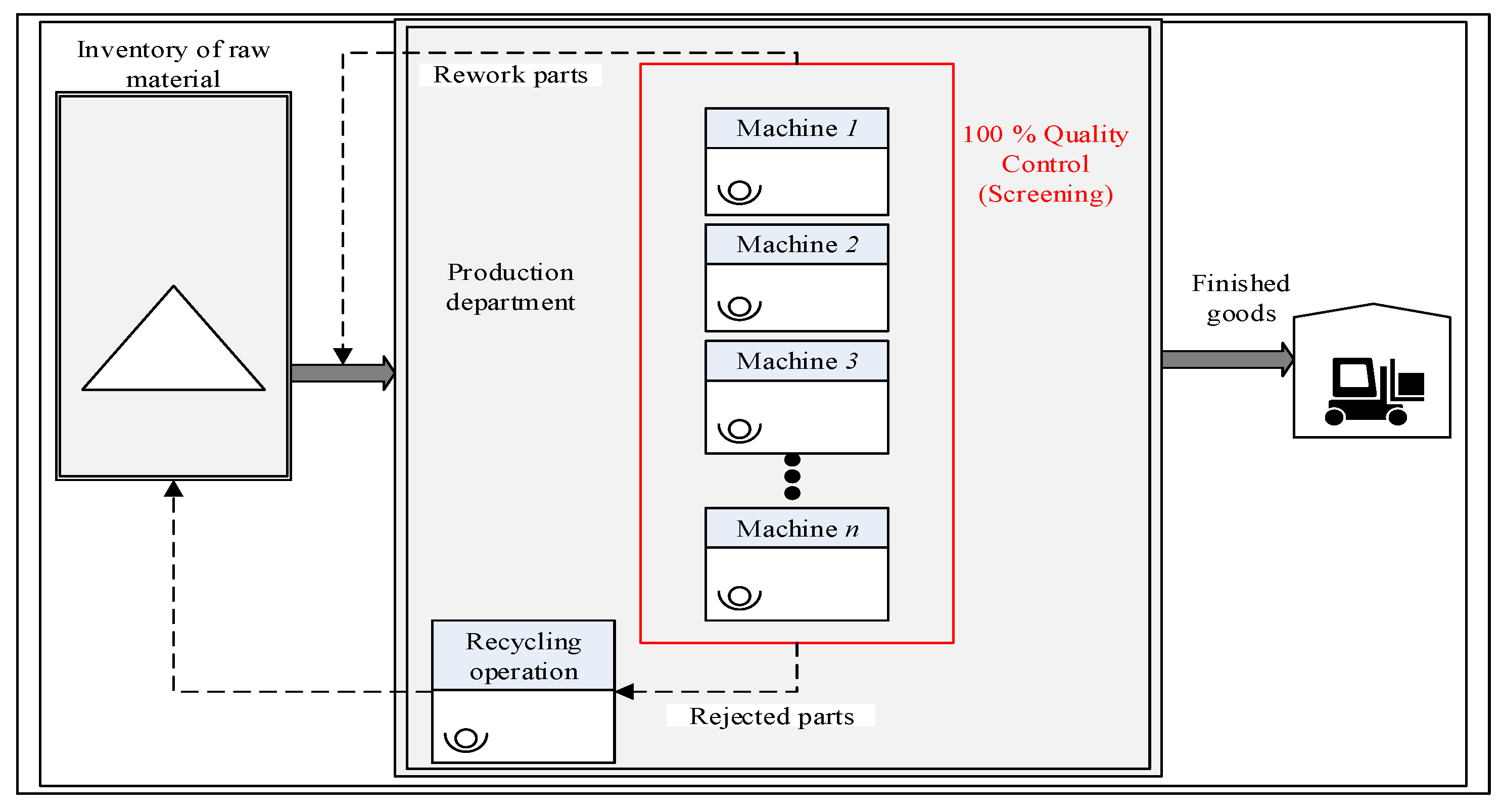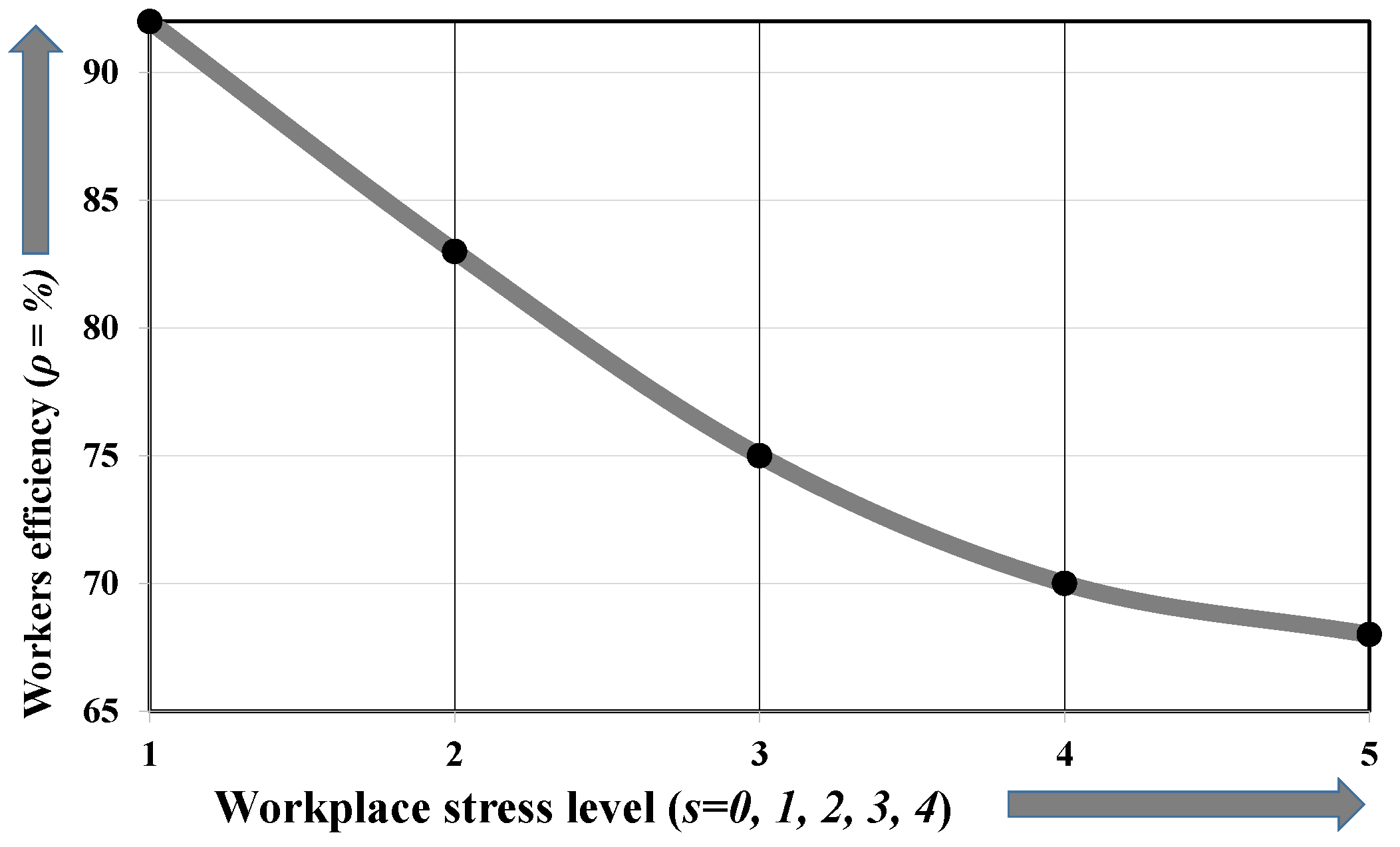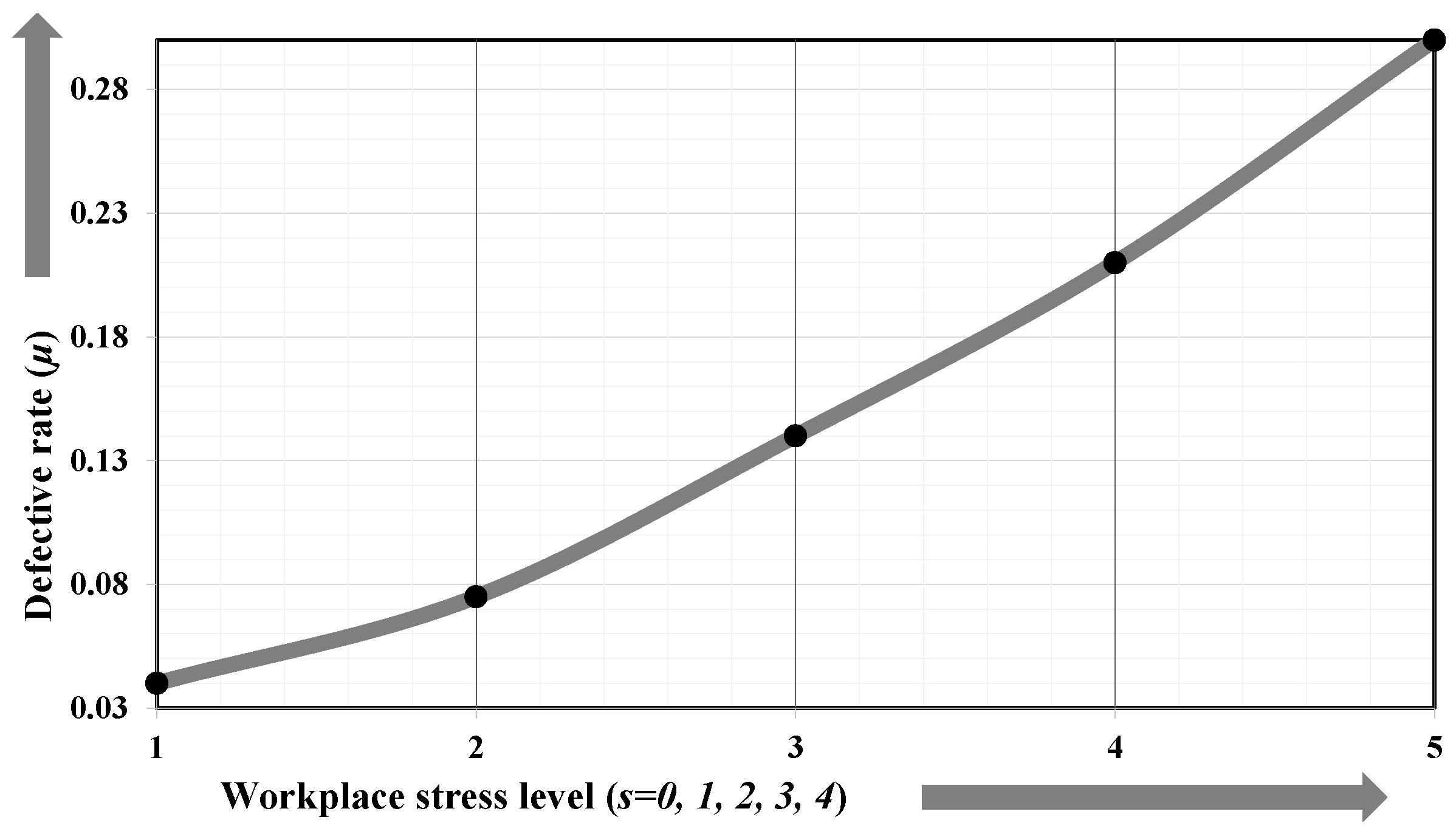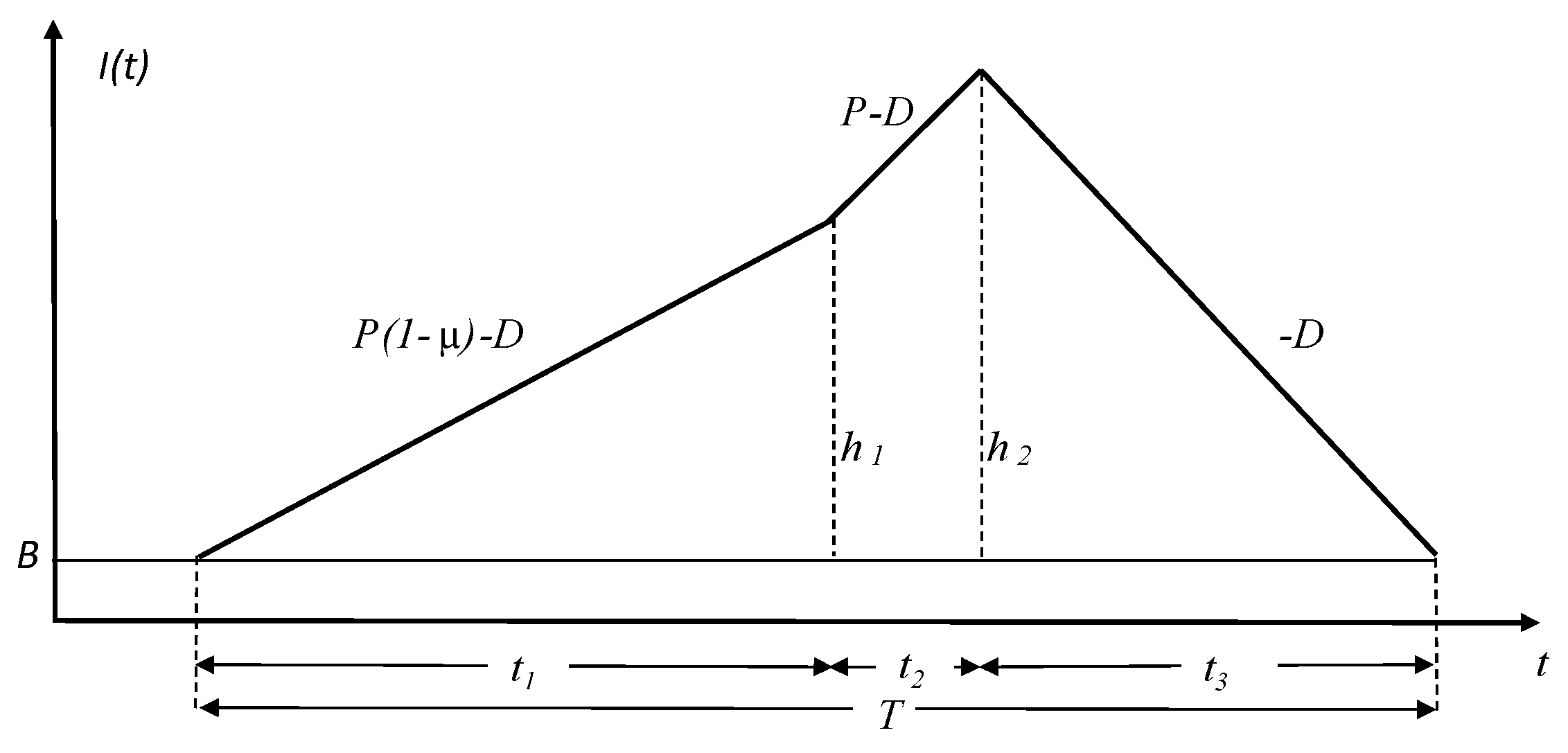The Quantitative Analysis of Workers’ Stress Due to Working Environment in the Production System of the Automobile Part Manufacturing Industry
Abstract
:1. Introduction
2. Literature Survey
3. Verbal Problem Statement
3.1. Stress Level and Efficiency
3.2. Stress Level and Defective Rate
4. Formal Problem Statement
4.1. Assumptions
- The model is considered for multiple type items.
- All products are screened and screening cost is incurred on each item [37].
- Defective rate is stress level-dependent and the initial defective rate is considered as uniformly distributed.
- Average efficiency of workers is also a function of stress level.
- The defective items are reworked to make the perfect quality products.
- Some parts are rejected after reworking the operation, which is recycled [38].
4.2. Notation
4.3. Mathematical Modelling
5. NumericaL Experiment
5.1. Data Collection
- All workers are participated in the survey irrespective of the age and health.
- They are working on the production floor as an operator or helper.
- The respondent unskilled workers are performing manual activities, e.g., loading, unloading, helping, operating, heavy working, manual forging, cutting etc.
5.2. Data Analysis
6. Results and Discussions
7. Sensitivity Analysis
- The scale can divided into five values of s levels from never, rarely, sometimes, often, and very often. An analysis is carried to quantify the exact amount of labor required by increasing the level of workers’ stress ranging from to as given in Table 5. In first case, by considering it is observed that when stress is increasing then there is no changes occurs. The reason is the demand for first part A is almost 180, which can be easily fulfilled by the same number of workers, that is, 111. The change in average stress would not create any variation in the production system to disturb the manual workers.
- By comparing the status of the labors required for part B and C, that is, and respectively at extreme levels of the stress, the labors required at and are 119 and 126 for item B while 124 and 137 for item C respectively. Indeed, the analysis is providing a quantitative impact of the stress level on the number of workers required in the production system.
- Since the stress is a variable factor and there is also a need to analyze the sensitivity of the proposed model for the TC by changing the stress among workers. It is clear that the model is sensitive to the stress on the basis of TC and labors required for each part, that is, the total cost of production and labor requirements are increased by increasing the stress from level to level. However, the mathematical calculations are required. When comparing the extreme levels of the workplace stress, it is found that at , the total cost of production is around $420,601, and at , the value increased to $432,410.
- The machines (, , and ) are not changing by increasing the average stress among the workers because the capital cost is enough that it cannot be effected by the average stress among workers. The efficiency of the workers is inversely proportional whereas the defective rate is directly proportional to the workplace stress.
8. Conclusions
Author Contributions
Funding
Conflicts of Interest
Abbreviations
| Indices | |
| j | the index used to indicate the number of items, |
| Decision variables | |
| n | number of cycles (number) |
| T | Cycle time of production (years) |
| Number of labors work to manufacture jth item (numbers) | |
| Number of capital units utilized to manufacture jth item (numbers) | |
| Parameters | |
| average wage of labor to manufacture jth item ($/labor) | |
| backorder of jth item ($/unit/year) | |
| fixed backorder cost to fulfill the shortages of jth item ($/year) | |
| variable backorder cost to fulfill the shortages of item jth ($/unit) | |
| holding cost of each item per cycle ($/unit/year) | |
| production rate (units/year) | |
| cost of each machine unit require to manufacture jth item ($/machine/year) | |
| demand rate, units per planning period (unit/year) | |
| units of energy utilised to manufacture jth item (kwh/unit) | |
| s | average stress among workers (number) |
| m | scale element for stress level of worker (constant) |
| setup cost for jth item ($/year) | |
| reworking cost of jth item ($/unit) | |
| labor share (%) | |
| capital share (%) | |
| availability factor (%) | |
| fixed inspection cost of item jth ($/year) | |
| variable inspection cost of item jth ($/unit) | |
| cost of energy per unit required for jth item ($/kWh/unit) | |
| scrap rate for recycling (%) | |
| recycling cost of item jth ($/unit) | |
| total defective rate (percentage) | |
| initial defective rate (percentage) | |
| scaling parameter (positive constant) | |
| shape parameter (positive constant) | |
| c | capacity of each item (%) |
| C | total capacity of inventory (%) |
| the average efficiency of workers (%) | |
| total inventory of the production system (units) | |
| TC | total cost of production model($/cycle) |
Appendix A
Appendix B
| Sr. | Questions | Never | Rarely | Sometimes | Often | Very Often |
|---|---|---|---|---|---|---|
| 1 | In general, I am not particularly proud or satisfied with my job. | 1 | 2 | 3 | 4 | 5 |
| 2 | Conditions at work are unpleasant or sometimes even unsafe. | 1 | 2 | 3 | 4 | 5 |
| 3 | I feel that my job is negatively affecting my physical or emotional well-being. | 1 | 2 | 3 | 4 | 5 |
| 4 | I have too much work to do and/or too many unreasonable deadlines. | 1 | 2 | 3 | 4 | 5 |
| 5 | I find it difficult to express my opinions or feelings about my job conditions to my superiors. | 1 | 2 | 3 | 4 | 5 |
| 6 | I feel that job pressures interfere with my family or personal life. | 1 | 2 | 3 | 4 | 5 |
| 7 | I don’t have adequate control or input over my work duties. | 1 | 2 | 3 | 4 | 5 |
| 8 | I do not receive appropriate appreciation or rewards for good performance. | 1 | 2 | 3 | 4 | 5 |
| 9 | I cannot utilize my skills and talents fully at work. | 1 | 2 | 3 | 4 | 5 |
| 10 | I tend to have frequent arguments with superiors, co-workers, or customers. | 1 | 2 | 3 | 4 | 5 |
References
- Perla, A.; Nikolaev, A.; Pasiliao, E. Workforce management under social link based corruption. Omega 2018, 78, 222–236. [Google Scholar] [CrossRef]
- Barney, J.B. Gaining and Sustaining Competitive Advantage; Addison-Wesley Pub. Co.: Boston, MA, USA, 1997. [Google Scholar]
- Choudhry, R.-M.; Fang, D. Why operatives engage in unsafe work behavior: Investigating factors on construction sites. Saf. Sci. 2008, 46, 566–584. [Google Scholar] [CrossRef]
- Leka, S.; Jain, A.; Zwetsloot, G.; Cox, T. Policy-level interventions and work-related psychosocial risk management in the European Union. Work Stress 2010, 24, 298–307. [Google Scholar] [CrossRef]
- EU-OSHA—European Agency for Safety and Health at Work. Expert Forecast on Emerging Psychosocial Risks Related to Occupational Safety and Health; European Agency for Safety and Health at Work: Bilbao, Spain, 2007.
- Kumar, S. Theories of musculoskeletal injury causation. Ergonomics 2001, 44, 17–47. [Google Scholar] [CrossRef] [PubMed]
- NIOSH. Stress…at Work; National Institute for Occupational Safety and Health (NIOSH): Washington, DC, USA, 1999; Volume 20, pp. 99–101.
- Karasek, R. Demand/control model: A social-emotional, and psychological approach to stress risk and active behavior development. In ILO Encyclopedia of Occupational Health and Safety; ILO: Paris, France, 1998. [Google Scholar]
- Leka, S.; Griffiths, A.; Cox, T.; World Health Organization (WHO). Work Organisation and Stress: Systematic Problem Approaches for Employers, Managers and Trade Union Representatives; WHO: Geneva, Switzerland, 2003. [Google Scholar]
- Palmer, S.; Cooper, C.; Thomas, K. A Model of Work Stress. Counselling at Work-Winter. Available online: https://s3.amazonaws.com/academia.edu.documents/31468591/acw_winter04_a.pdf?response-content-disposition=inline%3B%20filename%3DPalmer_S._Cooper_C._and_Thomas_K._2004_..pdf&X-Amz-Algorithm=AWS4-HMAC-SHA256&X-Amz-Credential=AKIAIWOWYYGZ2Y53UL3A%2F20190714%2Fus-east-1%2Fs3%2Faws4_request&X-Amz-Date=20190714T064506Z&X-Amz-Expires=3600&X-Amz-SignedHeaders=host&X-Amz-Signature=99276df961605f827720de490055880ce6bf5eefbf248336ac81476d42ddf3d9 (accessed on 6 April 2019).
- Dollard, M.-F.; Metzer, J.-C. Psychological research, practice, and production: The occupational stress problem. Int. J. Stress Manag. 1999, 6, 241–253. [Google Scholar] [CrossRef]
- Park, J. Work stress and job performance. Perspect. Labour Income 2008, 20, 7. [Google Scholar]
- Hendrick, H.-W. Determining the cost—Benefits of ergonomics projects and factors that lead to their success. Appl. Ergon. 2003, 34, 419–427. [Google Scholar] [CrossRef]
- Mrozek, J.-R.; Taylor, L.-O. What determines the value of life? A meta-analysis. J. Policy Anal. Manag. 2002, 21, 253–270. [Google Scholar] [CrossRef]
- Habib, M.-S.; Sarkar, B.; Tayyab, M.; Saleem, M.-W.; Hussain, A.; Ullah, M.; Omair, M.; Iqbal, M.-W. Large-scale disaster waste management under uncertain environment. J. Clean. Prod. 2019, 212, 200–222. [Google Scholar] [CrossRef]
- Omair, M.; Noor, S.; Hussain, I.; Maqsood, S.; Khattak, S.-B.; Akhtar, R.; Haq, I.-U. Sustainable development tool for Khyber Pakhtunkhwa’s dimension stone industry. Technol. J. 2015, 20, 160–165. [Google Scholar]
- Omair, M.; Noor, S.; Maqsood, S.; Nawaz, R. Assessment of Sustainability in Marble Quarry of Khyber Pakhtunkhwa Province Pakistan. Int. J. Eng. Technol. 2014, 14, 84–89. [Google Scholar]
- Kang, C.-W.; Imran, M.; Omair, M.; Ahmed, W.; Ullah, M.; Sarkar, B. Stochastic-Petri Net Modeling and Optimization for Outdoor Patients in Building Sustainable Healthcare System Considering Staff Absenteeism. Mathematics 2019, 7, 499. [Google Scholar] [CrossRef]
- Amador-Rodezno, R. An overview to cersss self evaluation of the cost-benefit on the investment in occupational safety and health in the textile factories: A step by step methodology. J. Saf. Res. 2005, 36, 215–229. [Google Scholar]
- Boone, J.; van Ours, J.-C. Are recessions good for workplace safety? J. Health Econ. 2006, 25, 1069–1093. [Google Scholar] [CrossRef] [PubMed] [Green Version]
- Ruhm, C.-J. Are recessions good for your health? Q. J. Econ. 2000, 115, 617–650. [Google Scholar] [CrossRef]
- Beehr, T.A.; Johnson, L.B.; Nieva, R. Occupational stress: Coping of police and their spouses. J. Organ. Behav. 1995, 16, 3–25. [Google Scholar] [CrossRef]
- Caplan, R.D.; Jones, K.-W. Effects of work load, role ambiguity, and type A personality on anxiety, depression, and heart rate. J. Appl. Psychol. 1975, 60, 713–719. [Google Scholar] [PubMed]
- Motowidlo, S.-J.; Packard, J.-S.; Manning, M.-R. Occupational stress: Its causes and consequences for job performance. J. Appl. Psychol. 1986, 71, 618–629. [Google Scholar] [CrossRef]
- Knauth, P. Innovative worktime arrangements. Scand. J. Work Environ. Health 1998, 24, 13–17. [Google Scholar]
- Mansour, M. Quantifying the intangible costs related to non-ergonomic work conditions and work injuries based on the stress level among employees. Saf. Sci. 2016, 82, 283–288. [Google Scholar] [CrossRef]
- Wilkinson, J. Shift work and fatigue-and the possible consequences. Occup. Health Wellbeing 2013, 65, 27–30. [Google Scholar]
- Dyble, J. Workplace stress linked to lower productivity. Empl. Benefits 2014, 9, 2014. [Google Scholar]
- Locke, E.-A. Toward a theory of task motivation and incentives. Organ. Behav. Hum. Perform. 1968, 3, 157–189. [Google Scholar] [CrossRef]
- Harvard, P.-S. Maslow, mazes, minotaurs; updating employee needs and behavior patterns in a knowledge-based global economy. J. Knowl. Econ. 2010, 1, 117–127. [Google Scholar] [CrossRef]
- Wee, H.-M.; Yu, J.; Chen, M.-C. Optimal inventory model for items with imperfect quality and shortage backordering. Omega 2007, 35, 7–11. [Google Scholar] [CrossRef]
- Ganguly, B.; Pareek, S.; Sarkar, B.; Sarkar, M.; Omair, M. Influence of controllable lead time, premium price, and unequal shipments under environmental effects in a supply chain management. RAIRO-Operations Res. 2018. [Google Scholar] [CrossRef]
- Goyal, S.-K.; Cárdenas-Barrón, L.-E. Note on: Economic production quantity model for items with imperfect quality–a practical approach. Int. J. Prod. Econ. 2002, 77, 85–87. [Google Scholar] [CrossRef]
- Wook Kang, C.; Ullah, M.; Sarkar, M.; Omair, M.; Sarkar, B. A Single-Stage Manufacturing Model with Imperfect Items, Inspections, Rework, and Planned Backorders. Mathematics 2019, 7, 446. [Google Scholar] [CrossRef]
- Bouslah, B.; Gharbi, A.; Pellerin, R. Integrated production, sampling quality control and maintenance of deteriorating production systems with AOQL constraint. Omega 2016, 61, 110–126. [Google Scholar] [CrossRef]
- Jeang, A. Simultaneous determination of production lot size and process parameters under process deterioration and process breakdown. Omega 2012, 40, 774–781. [Google Scholar] [CrossRef]
- Sarkar, B.; Omair, M.; Choi, S.-B. A multi-objective optimization of energy, economic, and carbon emission in a production model under sustainable supply chain management. Appl. Sci. 2018, 8, 1744. [Google Scholar] [CrossRef]
- Omair, M.; Sarkar, B.; Cárdenas-Barrón, L.-E. Minimum quantity lubrication and carbon footprint: A step towards sustainability. Sustainability 2017, 9, 714. [Google Scholar] [CrossRef]
- Sarkar, B.; Cárdenas-Barrón, L.-E.; Sarkar, M.; Singgih, M.-L. An economic production quantity model with random defective rate, rework process and backorders for a single stage production system. J. Manuf. Syst. 2014, 33, 423–435. [Google Scholar] [CrossRef]
- The Marlin Company and American Institute of Stress (AIS). The Workplace Stress Scale; The Marlin Company and American Institute of Stress: North Haven, CT, USA; Yonkers, NY, USA, 1978. [Google Scholar]
- Aghilinejad, M.; Zargham Sadeghi, A.-A.; Sarebanha, S.; Bahrami-Ahmadi, A. Role of occupational stress and burnout in prevalence of musculoskeletal disorders among embassy personnel of foreign countries in Iran. Iran. Red Crescent Med. J. 2014, 16, e9066. [Google Scholar] [CrossRef] [PubMed]
- McCalister, K.-T.; Dolbier, C.-L.; Webster, J.-A.; Mallon, M.-W.; Steinhardt, M.-A. Hardiness and support at work as predictors of work stress and job satisfaction. Am. J. Health Promot. 2006, 20, 183–191. [Google Scholar] [CrossRef] [PubMed]
- Idrees, M.; Hafeez, M.; Kim, J.-Y. Workers’ age and the impact of psychological factors on the perception of safety at construction sites. Sustainability 2017, 9, 745. [Google Scholar] [CrossRef]
- Sarkar, B. Supply chain coordination with variable backorder, inspections, and discount policy for fixed lifetime products. Math. Probl. Eng. 2016, 2016. [Google Scholar] [CrossRef]
- Birgin, E.-G.; Haeser, G.; Ramos, A. Augmented lagrangians with constrained subproblems and convergence to second-order stationary points. Comput. Optim. Appl. 2018, 69, 51–75. [Google Scholar] [CrossRef]
- Mostafa, N.; Khajavi, M. Optimization of welding parameters for weld penetration in FCAW. J. Achiev. Mater. Manuf. Eng. 2006, 16, 132–138. [Google Scholar]
- Schittkowski, K. NLPQL: A fortran subroutine solving constrained nonlinear programming problems. Ann. Oper. Res. 1986, 5, 485–500. [Google Scholar] [CrossRef]
- Theodorakatos, N.-P.; Manousakis, N.-M.; Korres, G.-N. A sequential quadratic programming method for contingency-constrained phasor measurement unit placement. Int. Trans. Electr. Energy Syst. 2015, 25, 3185–3211. [Google Scholar] [CrossRef]




| Item Type | Demand (Units) | Production Rate (Units/Year) | Backorders (Units) | Scrap (%) | Energy (KWh) |
|---|---|---|---|---|---|
| A | 180 | 450 | 25 | 0.2 | 0.45 |
| B | 200 | 550 | 30 | 0.3 | 0.5 |
| C | 210 | 580 | 35 | 0.4 | 0.58 |
| Item Type | Manufacturing Cost ($/Unit) | Setup Cost ($) | Holding Cost ($/Unit/Year) | Fixed Backorder ($) | Variable Backorder ($/Unit) | Machine Cost ($) | Labor Cost ($/Unit) |
|---|---|---|---|---|---|---|---|
| A | 6 | 45 | 47 | 9 | 0.9 | 450 | 1.7 |
| B | 7 | 50 | 50 | 10 | 1 | 500 | 2 |
| C | 8 | 55 | 56 | 10.5 | 1.25 | 580 | 2.2 |
| Item Type | Variable Inspection Cost ($/Unit) | Fixed Inspection Cost ($) | Recycling Cost ($/Unit) | Energy Cost ($/Unit) | Initial Defective Rate (%) |
|---|---|---|---|---|---|
| A | 0.01 | 9.5 | 1.8 | 5 | 2.5 |
| B | 0.02 | 10 | 2 | 5 | 2.5 |
| C | 0.03 | 10.5 | 2.5 | 5 | 2.5 |
| Sr. No. | Item Type | Decision Variable | Optimal Result | Objective Function (TC) |
|---|---|---|---|---|
| 1 | 0.329 years | $428,248 | ||
| 2 | A | 56 machines | ||
| 3 | B | 60 machines | ||
| 4 | C | 60 machines | ||
| 5 | A | 111 workers | ||
| 6 | B | 123 workers | ||
| 7 | C | 131 workers |
| Parameter | Stress Level | |||||
|---|---|---|---|---|---|---|
| (This Paper) | ||||||
| TC | 420,601 | 422,469 | 426,464 | 428,248 | 429,438 | 432,410 |
| 111 | 111 | 111 | 111 | 111 | 111 | |
| 119 | 120 | 123 | 123 | 123 | 126 | |
| 124 | 126 | 131 | 131 | 132 | 137 | |
| 56 | 56 | 56 | 56 | 56 | 56 | |
| 60 | 60 | 60 | 60 | 60 | 60 | |
| 60 | 60 | 60 | 60 | 60 | 60 | |
| 1 | 0.93 | 0.875 | 0.84 | 0.818 | 0.765 | |
| 0.025 | 0.035 | 0.053 | 0.066 | 0.076 | 0.105 | |
© 2019 by the authors. Licensee MDPI, Basel, Switzerland. This article is an open access article distributed under the terms and conditions of the Creative Commons Attribution (CC BY) license (http://creativecommons.org/licenses/by/4.0/).
Share and Cite
Omair, M.; Ullah, M.; Ganguly, B.; Noor, S.; Maqsood, S.; Sarkar, B. The Quantitative Analysis of Workers’ Stress Due to Working Environment in the Production System of the Automobile Part Manufacturing Industry. Mathematics 2019, 7, 627. https://doi.org/10.3390/math7070627
Omair M, Ullah M, Ganguly B, Noor S, Maqsood S, Sarkar B. The Quantitative Analysis of Workers’ Stress Due to Working Environment in the Production System of the Automobile Part Manufacturing Industry. Mathematics. 2019; 7(7):627. https://doi.org/10.3390/math7070627
Chicago/Turabian StyleOmair, Muhammad, Misbah Ullah, Baishakhi Ganguly, Sahar Noor, Shahid Maqsood, and Biswajit Sarkar. 2019. "The Quantitative Analysis of Workers’ Stress Due to Working Environment in the Production System of the Automobile Part Manufacturing Industry" Mathematics 7, no. 7: 627. https://doi.org/10.3390/math7070627
APA StyleOmair, M., Ullah, M., Ganguly, B., Noor, S., Maqsood, S., & Sarkar, B. (2019). The Quantitative Analysis of Workers’ Stress Due to Working Environment in the Production System of the Automobile Part Manufacturing Industry. Mathematics, 7(7), 627. https://doi.org/10.3390/math7070627







